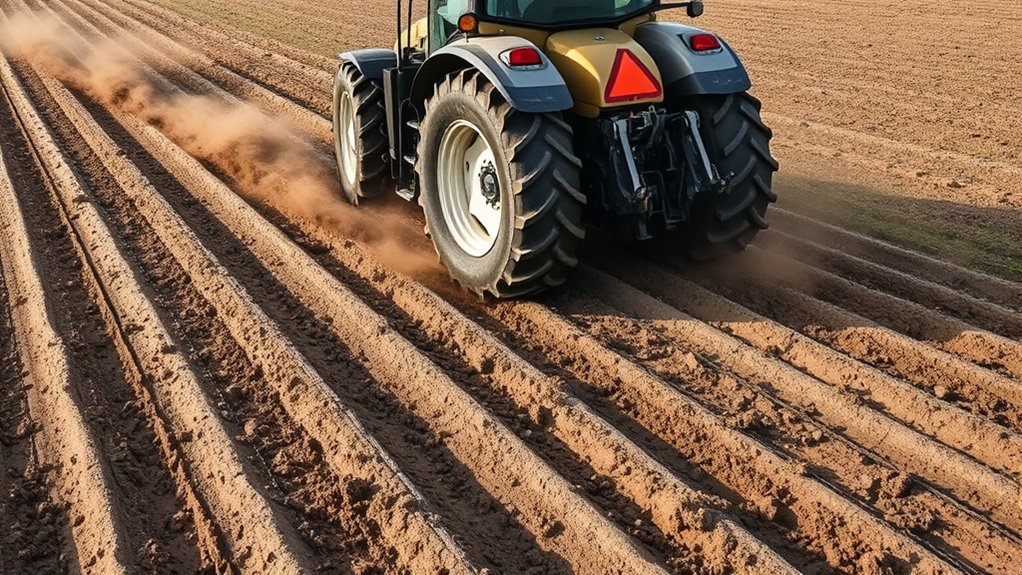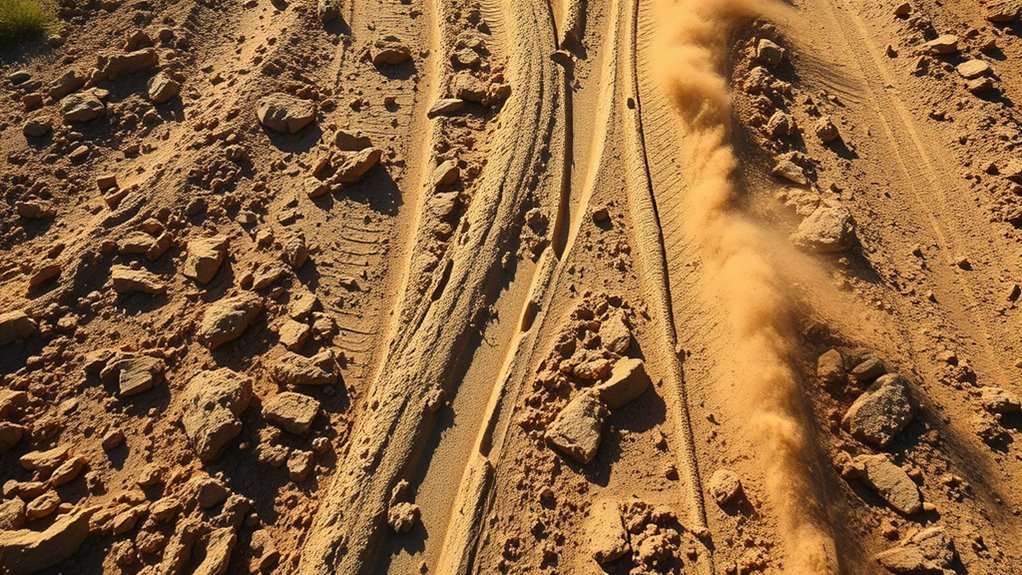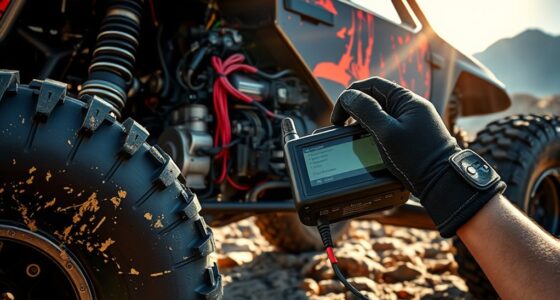When selecting a line through rutted corners, focus on avoiding deep or sharp ruts that can cause instability. Follow natural contours and look ahead for rut patterns, choosing smooth, broad paths that maintain traction. Steady steering and throttle help you preserve momentum, especially when using curved lines for stability. Prioritizing safe, predictable routes minimizes unnecessary corrections. To improve your approach and gain more control, discover how expert techniques can enhance your maneuvering skills.
Key Takeaways
- Analyze rut depth and shape to select the most stable and predictable line through the corner.
- Follow natural terrain contours to minimize abrupt turns and reduce lateral forces.
- Choose lines that allow smooth, controlled entry and exit to maintain momentum and vehicle balance.
- Avoid sharp edges and loose debris that can cause slipping or destabilize the vehicle.
- Continuously observe terrain changes to adapt your line, preserving traction and preventing momentum loss.
Understanding the Impact of Rutted Corners on Machinery Dynamics

Rutted corners considerably influence machinery dynamics by altering the vehicle’s path and stability. As you navigate these corners, the uneven surface causes your equipment to bounce and drift, challenging your control. Ruts can create unpredictable lateral forces, pushing your machinery sideways and reducing traction. This instability makes it harder to maintain a consistent line, risking loss of momentum or even tipping. You’ll notice increased vibrations and steering corrections needed to stay on course. The deep or sharp ruts amplify these effects, demanding greater operator skill and precise adjustments. Understanding how rutted corners impact your machinery’s behavior helps you anticipate and respond effectively, ensuring safer, more efficient navigation while conserving momentum through tricky terrain. Being aware of terrain interaction can further improve your handling and safety.
Factors Influencing Line Choice in Difficult Terrains

When maneuvering through challenging terrains, your choice of line plays a essential role in maintaining control and momentum. Factors like the rut depth and width, terrain slope, and surface consistency influence your decision. Opting for a line that follows the natural contour can reduce abrupt turns and minimize slip. Avoid sharp edges or loose debris that may cause loss of traction. Consider the vehicle’s capabilities, including turning radius and clearance, to select a line that offers stability. Additionally, anticipate how the terrain’s features, such as rocks or soft spots, could impact your path. Proper line selection can significantly improve your ability to navigate difficult terrains safely while preserving momentum. Your goal is to choose a route that preserves momentum while ensuring safety and control, avoiding unnecessary obstacles that could hinder progress or cause damage.
Techniques for Maintaining Momentum During Turns

As you approach rutted corners, your focus should be on steady steering and smooth throttle adjustments. Maintaining consistent pressure helps preserve your momentum and keeps the vehicle stable. Mastering these control techniques makes it easier to navigate challenging turns without losing speed. Additionally, understanding vehicle dynamics can further enhance your ability to respond effectively during turns.
Approaching Rutted Corners
To maintain momentum when approaching rutted corners, you need to focus on your line and speed management. Pick a smooth, predictable line that allows you to stay balanced and avoid sudden movements. Reduce speed early enough to handle the ruts without losing control or momentum. Look ahead to identify the deepest ruts and plan your path around or through them. Keep your body centered and relaxed to absorb bumps smoothly. Incorporating proper costume selection can also boost your confidence and performance during the ride.
Steering and Throttle Control
Effective steering and throttle control are essential for maintaining momentum through rutted corners. You want to keep your steering smooth and deliberate, avoiding sharp turns that can slow you down or cause you to lose grip. As you approach the turn, ease into the throttle to maintain steady power, then adjust gradually as you navigate the ruts. Keep your throttle consistent to prevent unexpected shifts in speed, which can upset your balance. Use small, controlled steering inputs to follow your ideal line, staying centered in the rut without overcorrecting. Maintaining a steady throttle and smooth steering helps you stay on the desired path, conserve momentum, and reduce the risk of slipping or getting stuck. Practicing these techniques enhances control and confidence in rutted corners, allowing for smoother navigation and better overall performance.
Comparing Straight and Curved Line Approaches

When choosing between straight and curved lines through rutted corners, you’ll notice different effects on momentum. Straight lines tend to maintain a direct path, reducing the chances of losing speed, while curved lines can help smooth out the turn but may cost some momentum. Understanding these impacts helps you decide which approach best preserves your momentum under varying conditions. Additionally, considering the body’s response to different maneuvers can aid in optimizing your technique for better control and efficiency.
Straight vs. Curved Lines
Choosing between straight and curved lines in rutted corners considerably impacts momentum conservation. Straight lines offer simplicity and predictability, making vehicle control easier. They tend to maintain a consistent trajectory, reducing sudden shifts that could cause momentum loss. Curved lines, on the other hand, allow for smoother progressions through corners, helping to distribute forces more evenly. They can enhance stability and reduce sharp steering inputs. However, curved approaches often require more precise steering and planning. Additionally, selecting the appropriate line type can influence the overall handling performance of the vehicle during cornering.
Impact on Momentum Conservation
The way you select your line through rutted corners directly influences how well you conserve momentum. Choosing a straight line often keeps your speed steady but can cause abrupt steering inputs, leading to energy loss. Curved lines, on the other hand, allow for smoother navigation, reducing lateral forces and minimizing momentum loss. When you follow a curved approach, you distribute your weight more evenly, maintaining better control and speed through the corner. However, if the curve is too tight, it can introduce unnecessary drag and slow you down. Balancing your line choice is essential; a well-planned curved line can preserve more momentum than a straight one, especially in rutted conditions where maintaining a smooth trajectory prevents sudden jarring movements. Additionally, understanding the effectiveness of different line choices can help optimize your cornering technique for better momentum conservation.
Practical Strategies for Operator Decision-Making

Operators can substantially improve their efficiency by adopting practical decision-making strategies when selecting lines in rutted corners. Focus on analyzing rut depth and shape to choose the most stable path. Assess the vehicle’s momentum and adjust your entry angle to maintain balance. Use visual cues, like tire tracks and rut consistency, to identify the best line that conserves energy. Additionally, choosing a line that aligns with the bike’s power output helps ensure sufficient momentum is maintained through challenging sections.
- Prioritize lines that minimize sharp turns and sudden directional changes
- Keep a steady speed to avoid losing momentum or getting stuck
- Continuously observe rut conditions and adapt your approach accordingly
Implementing these strategies helps you make quick, informed decisions, reducing the risk of slipping or damaging the vehicle. Staying attentive to the terrain ensures smoother navigation and better momentum conservation.
Implementing Best Practices for Safety and Efficiency

Implementing best practices for safety and efficiency begins with maintaining awareness of your surroundings and vehicle condition. Always scan ahead to identify potential hazards and adjust your line accordingly. Regularly check your equipment to ensure brakes, tires, and steering are in prime shape, preventing breakdowns or accidents. Use smooth, deliberate movements to maintain control, especially when maneuvering rutted corners. Follow established protocols and speed limits to reduce risks and conserve momentum. Staying alert for changes in terrain or rut patterns that could impact your line choice is essential. Proper cleaning and maintenance of your equipment can prevent issues that compromise safety and performance. Communicate clearly with your team when necessary, and avoid rushing through tricky sections. By staying vigilant and proactive, you enhance safety and keep your operations running smoothly, conserving momentum without compromising safety.
Frequently Asked Questions
How Does Soil Type Affect Line Selection in Rutted Corners?
Soil type directly impacts how you choose your line in rutted corners. With loose or sandy soil, you should aim for a wider, more gradual line to maintain traction and avoid slipping. For clay or compacted soils, a tighter line helps conserve momentum and reduces the risk of getting stuck. You need to adapt your approach based on soil consistency to optimize control and speed through challenging sections.
Can Automated Systems Optimize Line Choices in Complex Terrains?
You can leverage automated systems to optimize line choices in complex terrains by utilizing advanced sensors and algorithms that analyze terrain features in real time. These systems process data on soil, ruts, and obstacles, allowing you to select the most efficient path that conserves momentum and reduces wear. By adapting dynamically, automation helps you navigate challenging areas more effectively, improving safety, efficiency, and overall performance.
What Role Does Weather Play in Maintaining Momentum During Turns?
Weather acts like an invisible hand guiding your momentum during turns. When it’s wet, rain slicks the surface, making it harder to maintain grip and causing you to lose speed. Wind can also push against you, sapping your energy. To stay confident in these conditions, you need to adjust your approach, lean into the turn, and stay smooth—like a boat cutting through choppy waters—preserving your momentum.
How Do Different Machinery Types Influence Line Selection Strategies?
You should consider how different machinery types affect your line selection strategies. For heavier equipment, you might choose wider, more gradual turns to reduce strain and maintain momentum. Faster machinery benefits from tighter lines to optimize speed and efficiency. You need to adapt your approach based on machinery size, weight, and turning capabilities, ensuring you preserve momentum and avoid unnecessary wear or delays during cornering.
Are There Environmental Considerations When Choosing Lines in Rutted Areas?
You might find that choosing the right lines in rutted corners has subtle environmental impacts. By carefully selecting paths that minimize soil disturbance and reduce erosion, you help protect delicate ecosystems and maintain soil health. Opting for lines that avoid overly compressed or sensitive areas demonstrates your commitment to sustainable practices. In doing so, you balance effective momentum conservation with ecological responsibility, ensuring the land remains resilient and productive for future use.
Conclusion
Mastering line selection in rutted corners is like steering through a storm—you need skill, intuition, and a steady hand. When you choose the right path, you keep your momentum alive, gliding smoothly like a dancer on a tightrope. Trust your instincts, adapt to the terrain, and let your confidence lead the way. With every turn, you’re not just maneuvering; you’re orchestrating a symphony of precision and power that keeps you moving forward.








